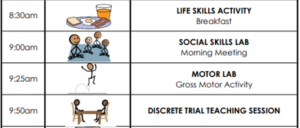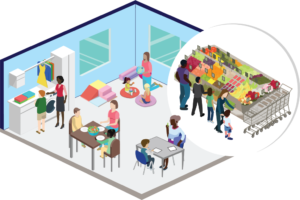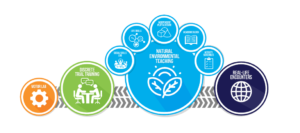By Jess Miller, BCBA and Regional Instructional Specialist at SESI
Think back to your classroom experiences as a child. Most of us would probably say that they were pretty manageable, with a few difficulties here and there as exceptions. We had our classroom schedules memorized, we were able to ask for alternative workspaces if the classroom was too loud, and we could grab a snack out of our backpack if we were hungry.
Now, consider the students that SESI serves often don’t have the necessary skills to accomplish these day-to-day tasks on their own. Their communication abilities are limited, which creates an environment in which they’re reliant upon others to have their wants and needs met. And this reliance often presents itself as students repeating the behaviors that have resulted in them having those wants and needs met. At SESI, our staff utilize the principles of Applied Behavior Analysis (ABA) to work with students on increasing their means of functional communication. These strategies are specialized and individualized to meet each student’s needs and are often implemented through our B.E.S.T. programming model, which employs many principles of ABA in our classrooms.
How ABA Principles Are Applied in SESI Classrooms
Applied Behavior Analysis is “the science in which tactics derived from the principles of behavior are applied to improve socially significant behavior and experimentation is used to identify the variables responsible for the improvement in behavior” (Cooper et al., 2014). In our standalone schools and In-District Classrooms, we utilize the principles of ABA to identify behaviors of concern for the individual and determine the strategies that will work best to improve their quality of life. This often means increasing the student’s means of functional communication – getting their wants and needs met with their words rather than with potentially dangerous behaviors. Our B.E.S.T. classroom model also incorporates many ABA principles, which we’ll discuss shortly.
The Use of Visuals
 An antecedent is defined as “an environmental condition or stimulus change existing or occurring prior to the behavior of interest” (Cooper et al., 2014). In other words, the antecedent is what happens directly before a behavior. Antecedent strategies are our way of being proactive rather than reactive. One great example of an antecedent strategy is the use of visuals inside of the classroom. These visuals include visual schedules, first/then boards, visual rules, and others. Keep in mind– for these strategies to work, we need to make sure that these supports are individualized for each student.
An antecedent is defined as “an environmental condition or stimulus change existing or occurring prior to the behavior of interest” (Cooper et al., 2014). In other words, the antecedent is what happens directly before a behavior. Antecedent strategies are our way of being proactive rather than reactive. One great example of an antecedent strategy is the use of visuals inside of the classroom. These visuals include visual schedules, first/then boards, visual rules, and others. Keep in mind– for these strategies to work, we need to make sure that these supports are individualized for each student.
- Visual schedules are a visual representation of what the student will be doing throughout the day. Some students prefer a visual schedule that shows their entire day, others benefit from just pieces at a time. When individualizing a visual schedule, we must keep in mind how the visual schedule is represented; will there be only pictures, will there be pictures and words, or just words? For students unable to read, just utilizing pictures will probably be the most effective method. These pictures might be of the students engaging in the activities themselves, animated versions of the activity, or pictures associated with the activity. For students who are able to read, we would include words in their schedules. All students should have access to their visual schedule throughout the day to ensure they are aware of each day’s events. The use of visual schedules solidifies the use of routines, which students on the autism spectrum benefit from greatly.
- For students who benefit only from seeing pieces of their schedule, a first/then board—which is a visual representation of what’s happening right now and what will happen right after—is commonly used. This is usually in the form of an unpreferred activity followed by a preferred activity. Like visual schedules, first/then boards are a combination of pictures and words that best fit the individual student. First/then boards are effective for a variety of reasons…one being that they create predictability in the student’s day by making them aware of what their expectation is right now and what they get as soon as it’s over. Similarly, first/then boards also serve as a reminder that good things are coming. Some students utilize these boards throughout their entire day, others use them during portions of their day. This sense of predictability can result in students not feeling the need to engage in dangerous behaviors in order to get their needs met, because they know good things are coming.
- Visual rules inside the classroom support students and help them remember what the expectations are without being reminded verbally. With many students, it’s easier to forget that the expectations placed on them are often outside their comfort zones. Providing visual rules to remind them of their expectations allows them to correct themselves before engaging in behaviors that are not preferred. Visual rules can be classroom-wide, such as how to sit on the carpet, or they can be specific to each student. Not only are visual rules supportive of students, but they can also support the staff by holding students accountable to their expectations. Visual rules are often represented in the form of pictures–sometimes even of the students themselves engaging in the expected behavior. Again, these supports should be individualized and meaningful for the students.
Reinforcement
Reinforcement–the addition or the removal of a stimulus in order to increase the likelihood of a behavior happening again in the future–is another important strategy that we utilize at SESI. It’s important to keep in mind, however, that is only reinforcement if it changes future behavior. Reinforcement in the form of verbal praise uses language such as, “Great job pushing in your chair!” or “I love that you raised your hand!”. These statements are behavior-specific so students know exactly which behavior they engaged in that was being addressed. Tangible reinforcement, on the other hand, is a physical form of reinforcement, such as a piece of candy, a toy, or other physical items that appeal to a student’s senses. In the case of tangible reinforcement, it’s important to utilize tools like preference assessments to ensure that the rewards being offered to the students are actually motivating for them.
Data Analysis
Another component of ABA that SESI employs is the use of data collection and data analysis to determine whether our strategies are working. Taking data that is available to us, we are able to see exactly when our program started working and what types of modifications may be necessary. Without data to back up our interventions, it becomes much more difficult to determine if what we’re doing is effective. Data should be collected on the occurrence of behaviors we want to see increase as well as behaviors we look to decrease; from there, we can better formulate a strategy to address both desirable and undesirable behaviors.
Using the B.E.S.T. Model in Our Classrooms

Each SESI student enrolled in our Broad-Based Education Services and Therapies (B.E.S.T.) Model experiences principles of ABA therapy every day in the classroom, as this model uses individualized behavior programming tailored to their specific needs; these needs are identified during a Functional Behavioral Assessment (FBA). By identifying the behaviors that disrupt a student’s ability to access learning, we can use data collected from the FBA and the classroom to create strategies that address the root cause of disruptive behavior and provide students with the tools necessary to develop positive replacement behaviors.
The B.E.S.T. Model employs SESI’s Behavior Management System, which is reinforced through the use of six effective teaching strategies:
- Prompting: Providing hints and cues to evoke a correct answer gives the students the ability to learn independent thoughts.
- Social and Tangible Reinforcement: As we mentioned earlier, each student has a variable reinforcement schedule; work is reinforced at a variety of times to increase motivation toward completion.
- Errorless Learning: A method of applying prompting prior to a learner providing a working answer with the intentions that exposing the student to the correct answer will allow them to learn a skill faster.
- Visible Supports: Also mentioned earlier, specifically setting up the learning environment with visual cues helps evoke learning such as, but not limited to, social stories, visual schedules, visual rule list, PECS systems, visual labels, etc.
- Variable Reinforcement Schedule: Rewarding students with social praise and physical preferred items helps increase their desire to engage in work.
- Sensory Integration: Applying sensory integration tools to the learning environment enhances learning by giving students the ability to regulate their bodies.
Within our B.E.S.T. Model, each student spends a portion of the day rotating through different modalities of instruction. The skills a student learns in each modality are generalized and transition with that student to the next modality. The end goal is to ensure that the skills students learn can be utilized in new environments, influencing their ability to be independent in real-life encounters.
- Motor Lab: Through a sequence of progressive skills, which increase fine and gross motor abilities, students build motor skills and an understanding of their environment.
- Discrete Trial Training (DTT): DTT is an ABA strategy that is structured, fast-paced, 1:1 instruction designed to break down a student’s specific language skill into smaller “trials.” By breaking down these skills, we attempt to build up a brand-new skill. This is accomplished through repetition and a high frequency of reinforcement.
- Natural Environment Teaching (NET): Language-based social, play, and leisure skills are practiced in real-life simulations.

It bears repeating that the most important component of these strategies and learning models is that they are individualized for each specific student. The use of these specialized strategies and learning models that have roots in Applied Behavior Analysis create environments that foster behavior change. The common goal is to teach our students the skills that they need to be successful in the least restrictive environment, and ABA allows us to utilize evidence-based practices to increase the quality of life for our students.
Sources:
Cooper, J. O., Heron, T. E., & Heward, W. L. (2014). Applied Behavior Analysis. Pearson
About the author: Jess Miller, BCBA, is a Regional Instructional Specialist that supports BEST model programs in Specialized Education Services, Inc. She has been dedicated to working with students in SESI Schools for 6 years and continues to support the implementation of quality programming for students across the company.
